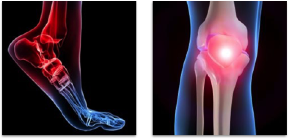
Jordi Sanchez-Ballester
FRCSEd FRCS Trauma & Orth
Consultant Foot, Ankle & Knee Surgeon
Fairfield Independent Hospital, St Helens
Spire Cheshire
Bone-Surgeon.co.uk
Fairfield Independent Hospital
Crank Rd
St Helens
Merseyside WA11 7RS
01744 739311
Spire Cheshire Hospital
Chris Davies
Fir Tree Close
Warrington WA4 4LU
0845 602 2500
Heel Pain
One in ten people will experience heel pain and for many, the problem will have a very significant impact upon their lives.
We have established a comprehensive service, offering the full range of advanced treatment options for people with long term, intractable heel pain. At our dedicated clinic, you can normally have your assessment, x-rays, opinion and first treatment all during your first visit.
About Heel Pain
There are two main types of heel pain, occurring in different places. A small number of people will have pain in both areas of the heel.
The ‘Grumbling’ Achilles – Non-insertional Achilles Tendinopathy
The ‘grumbling’ Achilles is known medically as non-insertional Achilles tendinopathy. Although a rupture of the Achilles is well known, it is actually more common to have what is known as a grumbling Achilles. The pain is felt at the back of the heel above where the Achilles tendon joins the bone. It feels stiff and swollen, particularly in the morning and can prevent the sufferer from taking part in sport. Sometimes the pain is lower down where the tendon joins the bone. This Insertional Achilles tendinopathy is less common.
Policeman’s Heel – Plantar Fasciitis
Policeman’s heel is known medically as plantar fasciitis because it occurs in a tendon called the fascia. The fascia is a strong band of tissue stretching from your heel to your toe bones. It supports the arch of your foot and acts as a shock absorber in the foot. Pain is felt at the bottom of the heel where it connects with the ground in each step. Pain and stiffness often leaves patients “hobbling” for the first few minutes in the morning. The pain can be severe, especially after standing for a long time. Plantar fasciitis is very common indeed and one of the main reasons for seeing a foot specialist.
All patients plantar fasciitis will receive an explanation of the condition and likely treatment which should emphasise its chronic self-limiting nature, self-help, the irrelevance of the spur and the low probability of needing surgery.
DOWNLOAD: More info on Plantar Fasciitis
For This Group Of Patients We Offer:
attention to footwear, occupational factors and obesity
simple analgesia
stretching
silicone heel seat where necessary
Patients who remain symptomatic despite compliance with the above should be re-evaluated for underlying disease. If none is found, second line treatment may include:
a dorsiflexion night splint, especially if morning pain is a prominent symptom
anti-inflammatory medication
Patients at any stage who have very severe symptoms, or patients who remain symptomatic after the above treatment, may be considered for
Extracorporeal shockwave therapy
A course of injections
Surgical calf stretching
Shockwave Therapy For Heel Pain
If shockwave therapy is indicated as the best treatment for your heel pain, you will have your first session during your initial visit to the Heel Pain Clinic.
Each session takes approximately 3–5 minutes. You will lie on your front while the shockwave is applied with a machine rather like a small pneumatic press.
Patients experience some discomfort during the procedure and there may be a little redness on the skin after treatment. Exceptionally, the heel pain becomes slightly worse after treatment before getting better. A total of three sessions are needed, with no more than one to two weeks between each session.
How Does Shockwave Therapy For Heel Pain Work?
It is understood that shockwave therapy works in two ways:
Shockwaves cause micro damage to tissue in the affected area and in so doing, stimulate healing. Nature gets a second chance.
The treatment has a direct effect on the nerve endings which make them less sensitive and therefore less likely to transmit pain.
The benefit of shockwave therapy for heel pain is often not felt until after the third session. The treatment works well for 80 per cent of patients. The effect of the treatment is usually permanent and there is no need to return for further sessions at a later date.
NICE (National Institute for Health and Clinical Excellence) recently evaluated shockwave therapy for heel pain in August 2009. The recommendation was that the treatment is effective and should be offered, providing centres audit their results and inform patients of possible side-effects. You can read the guidelines and evidence on the NICE website: www.nice.org.uk
Surgical Calf Stretching
Surgical calf stretching is a way of stretching the tight calf muscle in a very controlled way and allow release of strain from the affected heel area.”
Surgical calf stretching, known medically as Gastrocnemius Release is an established procedure. It is carried out as a day procedure and is minimally invasive, using a very small incision behind the knee.
Injections For Heel Pain
Injections are particularly helpful for people with neovascularity, when the Doppler scan shows there is a large number of small veins feeding a swollen tendon and perpetuating the pain. A course of three injections is normally given, with several weeks between each injection. Injections are undertaken with ultrasound guidance to ensure the injection reaches the target area.
There is no clearly superior method of non-surgical treatment. We therefore recommend that first line management be simple and cheap, reserving more expensive treatments for those who fail to respond to simple measures. We recognise that this stance may change if further evidence becomes available.